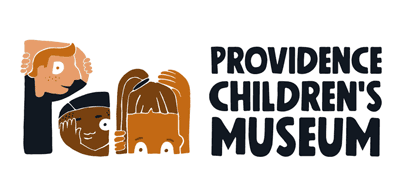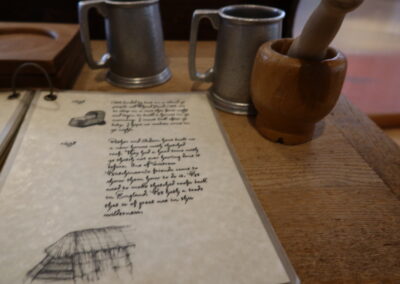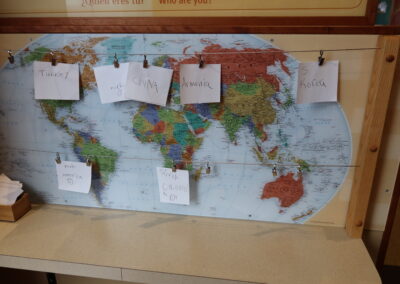Journaling the Journey
(FOCUS: 3rd Grade, History, Humanities, Writing, Language and Literacy, SEL)
Everyone living in the United States has an immigrant past, with the exception of Native Americans. Over the last few centuries, millions of people have made their way to America. Leaving one’s country is very challenging, and it is not a decision that immigrants do not take lightly. Some people, like enslaved people, came unwillingly. But most immigrants were drawn by the promise of greater freedom and opportunity.
In this lesson inspired by the Coming to Rhode Island exhibit at the Providence Children’s Museum, students will write a journal entry about immigrating to America, and more specifically, Rhode Island. This lesson encourages students to explore the immigration journey of others, including why people chose to come to America, how people came to America, and the challenges people face in getting to America. Students will also have the opportunity to share and connect to their own families’ immigration story.
Materials
- Whiteboard or chart paper and markers (for class discussion)
- Paper or notebooks and pencils
- Computers (if available), to type journal entries
- Guiding questions for journal entries
- *Teachers note: each guiding question could represent a different paragraph of one journal entry, or each guiding question could represent a different journal entry (possibly done on different days during a unit)
- Websites and videos about immigration (see below in prepare/background info section)
- Potential read aloud books (see below in prepare/background info section)
Student’s Job
Journal Prompt: Imagine that you are immigrating to Rhode Island by yourself. Using the guiding questions, write a journal entry about this journey.
Writing perspective options: students can choose a country to be from, their name, and background of their character. Or students can use a family member’s immigration story to base their journal off and take on that person’s home country, name, and background.
Guiding Questions:
- Give some background about your journey (based on choice above). Where are you leaving from? What are your reasons for coming to Rhode Island/America? How are you feeling about leaving? Are you traveling on your own? What will you miss from home? What are you excited about?
- You are not allowed to bring many items with you, one suitcase at the most. What would you bring? In detail, explain why those items are important to you. What familial/cultural traditions are you taking with you? Why are these important to you?
- Once you’ve “left” your home country, what happens? What do you see, hear, taste, smell? How are you traveling? How long will your trip take? What feelings are you experiencing during this journey?
- Once you “arrive,” what happens? What do you see, hear, taste, smell? How are you feeling now that you’ve made it to Rhode Island/America? What are people like? What are the cultural traditions in your new community?
Further Challenges:
It has taken 2 months for your journey to your new country. You finally see your long-awaited destination and realize that you cannot enter right away. You are detained for several weeks, possibly months, or more than a year in the barracks on Ellis Island or Angel Island. You have come to this new country with all the hopes and dreams of the family you left behind back home. All the time, money and energy you have spent might be wasted. Using descriptive words, write about some feelings that you may be experiencing and include supporting details. Write about what you would do with all the time waiting to find out what is going to happen to you.
Teacher’s Job
Standards Alignment
SOCIAL STUDIES: GEOGRAPHY 3 (3-4) – 1
Students understand why people do/do not migrate by comparing reasons why people have moved.
SOCIAL STUDIES: HISTORICAL PERSPECTIVES 2 (3-4) – 2
Students chronicle events and conditions by describing, defining, and illustrating by example Rhode Island historical individuals, groups and events (e.g., Roger Williams, Native Americans, immigrant groups) and how they relate to the context (e.g., conditions of the time, events before and after)
COMMON CORE STATE STANDARDS.ELA-LITERACY.SPEAKING & LISTENING.3.1
Engage effectively in a range of collaborative discussions (one-on-one, in groups, and teacher-led) with diverse partners on grade 3 topics and texts, building on others’ ideas and expressing their own clearly.
COMMON CORE STATE STANDARDS.ELA-LITERACY.WRITING.3.3
Write narratives to develop real or imagined experiences or events using effective technique, descriptive details, and clear event sequences.
COMMON CORE STATE STANDARDS.ELA-LITERACY.WRITING.3.4
With guidance and support from adults, produce writing in which the development and organization are appropriate to task and purpose. (Grade-specific expectations for writing types are defined in standards 1-3 above.)
COMMON CORE STATE STANDARDS.ELA-LITERACY.LANGUAGE.3.1
Demonstrate command of the conventions of standard English grammar and usage when writing or speaking.
COMMON CORE STATE STANDARDS.ELA-LITERACY.LANGUAGE.3.2
Demonstrate command of the conventions of standard English capitalization, punctuation, and spelling when writing.
Prepare/ Background Info
- Discussion about immigration
- Have students brainstorm a definition for “immigrant”, jot down students’ ideas
- Examples of people who have immigrated: famous immigrants, personal stories, students’ families, etc.
- Reasons why people immigrate to the US (past and present – government, jobs, education, war, religion, etc.)
- Challenges people face when immigrating (past and present)
- How people come to America (past & present)Ellis Island – east coast; primarily European immigrants (can talk about the Statue of Liberty)
- Can use Scholastic’s resources to take a tour and hear immigrant stories: Ellis Island Interactive Tour With Facts, Pictures, Video; Meet Young Immigrants; Relive a Boy’s Journey to America
- How people come to America (past & present)Ellis Island – east coast; primarily European immigrants (can talk about the Statue of Liberty)
- Angel Island – west coast; immigrants were Asians, Canadians, Mexicans, Central and South Americans, Russians, and Australians and New Zealanders
- Crossing the US/ Mexico border
- Visit the Coming to Rhode Island Exhibit at PCM – explore the history hunts and search through the story galleries to figure out why each of the immigrants came to Rhode Island, what they brought with them and what they left behind.
- Read Alouds (picture books):
- Grandfather’s Journey by Allen Say
- Dreamers by Yuyi Morales
- The Name Jar by Yangsook Choi
- Island Born by Junot Diaz
- The Keeping Quilt by Patricia Pollaco
- My Diary from Here to There/Mi Diario de Aqui Hasta Alla by Amada Irma Perez
Extend/ Take it Further
- Have students share their journals by reading aloud (to partners, small groups, or whole class)
- Interview someone who immigrated to the United States – record and write their oral history
- Create a timeline about immigration in Rhode Island (collaborative, group work)
- Writing: Compare & contrast the stories of immigrants from decades ago to those of recent immigrants (create a venn diagram and then turn that into a paragraph)
- Math: explore Immigration data and create their own graphs/tables
- Can start with Scholastic’s Explore Immigration Data page
- Art: celebrate students’ cultural backgrounds with a class quilt; students create an image on their square that represents their family culture.
- Other related voluntary & involuntary migration topics: Pilgrims, Trail of Tears, the slave trade, the Gold Rush, the Industrial Revolution, natural disasters (California wildfires, Hurricane Katrina, etc. – how they force people from their homes)
Facilitation Strategies
- It is likely that students have heard about immigration in some way or another. Because students may have varying background knowledge on the subject, it is important to fill in any gaps and correct misconceptions during the class discussion.
- To guide reflection and access knowledge of topic, you may want to make a chart with the students during the discussion about immigration (before they start journaling)
- Students should be able to work independently without much teacher direction. Clear expectations should be set prior to starting the activity so that students understand what they should and should not be doing.
- Modeling can be done, and sentence stems can be provided if needed for certain students. Encourage students to refer back to the guiding questions to ensure they include enough detail.
- Provide students with plenty of time to write their journal entries. When they finish, they can draw a picture to go along with their writing.
Play to Notice (Learning Framework)
- How well can students work independently to write their journal entry?
- Choice: The students can choose the frame for their narrative (create their own immigration story or base it off of a family member’s story). This helps the students use their imagination and creative thoughts.
- Active: Students will be very active in brainstorming and writing their journal entries.
- Emotional/Social: Students might have strong feelings during this lesson (discussion & writing). It is important to go over good coping strategies if these feelings arise.
Content Matter to Notice
Literacy: Notice the students’ writing skills, including grasp of grammar/conventions, use of vocabulary & descriptive words, and the development of their journal entry (i.e., logical sequencing).
SEL to Notice
- Can students clearly express their ideas/thoughts/opinions during the class discussion & writing process?
- Can students cope with/process their strong feelings during the class discussion & writing process?
- Can students problem-solve independently when feeling stuck about what to write?




0 Comments